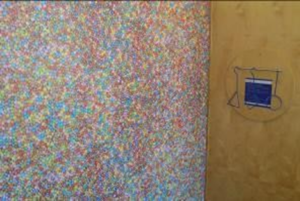Maths
If we count the number of smarties inside a frame, and then work out how many frames cover the poster, we can estimate the total number of smarties.
Or we can count how many smarties are inside the frame, and how many of them are blue smarties, and estimate the proportion of blue smarties.
It is easier to work out how many frames cover the picture when the frame is square or a triangle.
It is often possible to make a reasonable estimate of a quantity even if your information is incomplete.
The method has been formalised:
1. What will the answer look like, or what will be the units of the answer?
2. What sort of quantities do we need to know about?
3. How do these quantities relate to each other?
4. What figures do we know or can be guessed?
5. What reasonable assumptions can we make?
Using this method, could you estimate how many tennis balls fill a suitcase? Or how about how many packets of popcorn can fill a room?
Another way to estimate the total number is to take a survey of people’s best guesses, and using the average as your estimate. This works because some of these guesses will be too high, and some will be too low, but if we’re lucky the errors will cancel out. This is called Wisdom of the Crowds.

